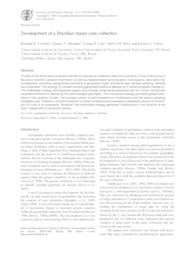Development of a Brazilian maize core collection.
Development of a Brazilian maize core collection.
Author(s): COIMBRA, R. R.; MIRANDA, G. V.; CRUZ, C, D.; SILVA, D. J. H.; VILELA, R. A.
Summary: The aim of this study was to evaluate methods for developing a Brazilian maize core collection. For an initial survey of the active collection, passport information, as well as characterization and evaluation of accessions, were taken into consideration, these then being divided according to geographic region and kernel-type. Multiple sampling methods were evaluated. The strategy of constant sampling generated extensive alterations in extract accession frequency. The multivariate strategy with dispersion graphs and principal components associated with the Tocher method was considered efficient for identifying the most divergent genotypes. The multivariate strategy generated greater alterations in the variance of traits. The average number of traits revealed few modifications with the various sampling strategies used. Therefore, the active collection could be considered as possessing a satisfactory amount of information for most of its accessions. Moreover, the multivariate strategy generated modifications in the variance of the traits, independent of sampling intensity.
Publication year: 2009
Types of publication: Journal article
Unit: Embrapa Maize & Sorghum
Keywords: Melhoramento, Milho
Observation
Some of Embrapa's publications are published as ePub files. To read them, use or download one of the following free software options to your computer or mobile device. Android: Google Play Books; IOS: iBooks; Windows and Linux: Calibre.
Access other publications
Access the Agricultural Research Database (BDPA) to consult Embrapa's full library collection and records.
Visit Embrapa Bookstore to purchase books and other publications sold by Embrapa.

